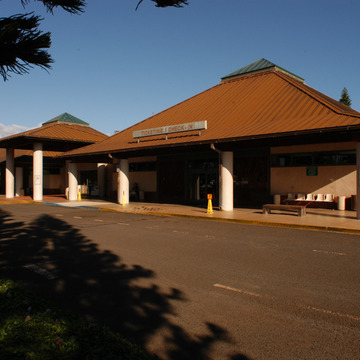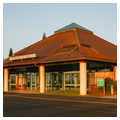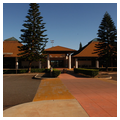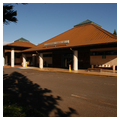Intimate in scale, nicely appointed, and evocative of Hawaii, the fifteen-thousand-square-foot airport gracefully welcomes people to the visitor-oriented Lanai of the twenty-first century. The T-shaped plan features three square pavilions linked by a flat-roofed, skylit foyer, and short concourse. Each pavilion houses separate functions: check-in, departure, and baggage claim. Subtle, clean detailing conveys an island ambiance. Large wrought-iron grilles depict tropical flora; scored-concrete floors are stained in hues of blue and red, reminiscent of the ocean and red dirt of the land; and wood from the island's ubiquitous Cook Island pine trees is used throughout the interior. A crisp modernity is found in the exposed, white air-conditioning ducts, PVC conduits, and green fluorescent light fixtures, all of which contrast with the timber of the open ceilings. A skylight and the trellislike corners of the eaves naturally illuminate the departure area.
You are here
Lanai Airport
If SAH Archipedia has been useful to you, please consider supporting it.
SAH Archipedia tells the story of the United States through its buildings, landscapes, and cities. This freely available resource empowers the public with authoritative knowledge that deepens their understanding and appreciation of the built environment. But the Society of Architectural Historians, which created SAH Archipedia with University of Virginia Press, needs your support to maintain the high-caliber research, writing, photography, cartography, editing, design, and programming that make SAH Archipedia a trusted online resource available to all who value the history of place, heritage tourism, and learning.









